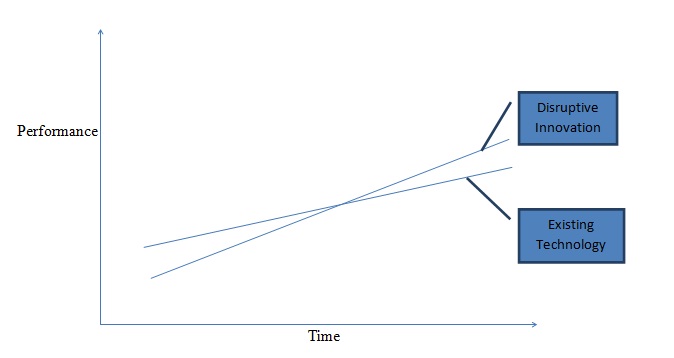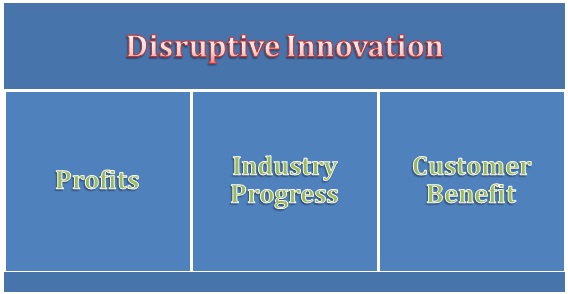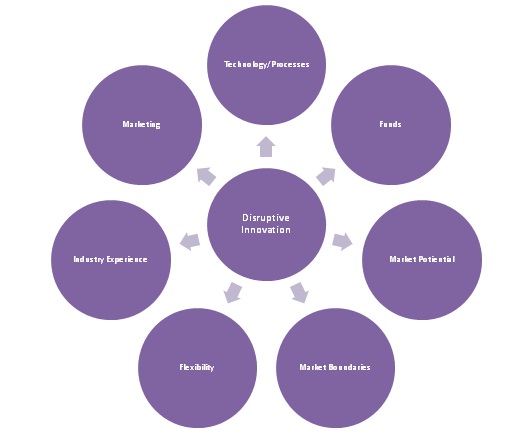- Articles ›
- Marketing and Strategy ›
- Disruptive Innovation: Strategist’s Dilemma Articles
Disruptive Innovation: Strategist’s Dilemma
From operational efficiency improvements to the new strategy development, all the organizations, be small size, medium size or large size, are looking at the ways to improve their profits. Usually, organizations continue to swim in the red ocean space and fit in the existing realm of things. However, sometimes, an innovation does occur in the blue ocean space that jolts the world right to its core. A totally new concept is introduced and this new concept, if not kills, challenges the existing norms. Over the period of time, this new innovation becomes the ideal model of the pertaining business due to which every other model loses its high ground and eventually becomes obsolete.


The introduction of such above mentioned concept is called Disruptive Innovation. Professor Clayton M. Christensen (Harvard Business School) defines Disruptive Innovation as product or service designed for a new set of customers.
"Generally, disruptive innovations were technologically straightforward, consisting of off-the-shelf components put together in a product architecture that was often simpler than prior approaches. They offered less of what customers in established markets wanted and so could rarely be initially employed there. They offered a different package of attributes valued only in emerging markets remote from, and unimportant to, the mainstream”.
Some of the examples of Disruptive Innovation are:
- CD drives disrupting Floppy drive market.
- DVD drives disrupting CD drive market.
- Digital media disrupting CD/DVD drive market.
- Digital Photography disrupting Chemical Photography market.
- Mobile Phone disrupting pager market.
Need for Disruptive Innovation
Although disruptive innovation is not necessary to survive in the industry, it is required in many ways. Following are some of the reasons for the need of disruptive innovation:

Profits
Most important need for disruptive innovation is to generate profits in a competitive industry.Disruptive innovation, with its new offerings, often helps the organization to generate profits at the large scale. With existing methodology, it is very difficult to produce higher margins because even competitors have similar technology, processes and products. So, to rise above the competition and generate higher than industry expected profits, organization has to go for disruptive innovation.
Industry Progress
After a while, industry tends to mature with existing set of technologies, innovations and products offerings and this leads to the reduction in investment in the industry. So, it is required to introduce the innovation to take the industry to the next level and maintain the interests of the investors.
Customer Benefit
Although never a direct intention, disruptive innovation eventually benefits the customer in a huge way. The concept of new innovation is usually laid down after analyzing the existing offerings, technologies and processes. So when new innovation is finally introduced, although not expected by potential customers, eventually the introduction of new technology, process or product eases the execution of the task and brings a whole new experience. Thus customer, after finally accepting this innovation, benefits to a great deal.
Factors responsible for successful disruptive innovation
Although disruptive innovation in itself is a potential success, there are underlying factors which have to be taken into account to make an innovation a successful one. Let’s consider the factors responsible for making the successful disruptive innovation and see what it takes an organization to be a one. Following are such factors:

Technology/Processes
Disruptive innovation is primarily based on the capabilities of the organization as technological/process leader or the vision of being a potential leader. The competency to come up with the entire new market space is usually backed up with an introduction of new technology/processes. Thus, if organization is willing to invest in new technologies/processes, it can very well bring the successful disruptive innovation.
Funds
Research in disruptive innovation is ideally backed up with large inflow of investment and thus any company venturing into the same needs a healthy amount of cash. So to introduce any such innovation, an organization needs to have a good amount of cash inflow to invest in research and hence not every organization is capable to go the disruptive way.
Market Potential
Market potential helps to determine the life cycle stage of the industry. If the industry is in its decline phase, then disruptive technology would not really yield that much profits as compared to when industry is in consolidation or maturity phase. Thus, it is important to evaluate the industry and its lifecycle stage to reap maximum benefits.
Market Boundaries
A market boundary is the concept where it is to be decided whether market boundaries are set internally or externally. If market boundary is internal, it can be expanded based on the innovations. However, if market boundary is external i.e. market boundary is set by external forces such as Government; it may not be very wise to go for innovation without examining the effect on the external forces.
Flexibility
Flexibility is one of the important factors in determining if disruptive innovation is right strategy for the organization and so in case of an integrated organization; it is difficult to go the disruptive way. A disruptive way may mean thatall the existing set of processes, partnerships, technologies have to be changed and this tends to be a big problem for the integrated organization which already has established way of doing things.
Industry Experience
Industry experience is also an important factor in pursuing the disruptive innovation. The company pursuing the innovation should have good idea of what, if invented/innovated would sit well with the customers and what would not be so effective with customers. Thus need of that vision has to be present in the organization pursuing disruptive innovation.
Marketing
After inventing a new technology, it is equally important to market it successfully so that customer is fully aware of its benefits. With any disruptive technology, it usually takes time to go from low performance to high one and then become the market leader. So, company has to put the continuous effort to market the disruptive technology in order to reap the maximum benefits and market team needs to be strong in order to show the customer the benefits of the new technology/process.
Dilemma
Till now, we have looked at the some of the reasons to go for disruptive innovation and factors that must be taken into account to when an organization is thinking about going for disruptive innovation. Let’s consider some of the consequences when an organization pursues disruptive innovation.
Disruptive innovation by definition means coming up with entire new technology and processes to achieve profits. Once organization is able to invent the technology or process, it has to implement it throughout its body. This is where the problem sets in. If an organization is an integrated one, it would find very difficult to change the entire set of processes and base technologies to implement this new innovation as implementing it would mean changing the existing norms of doing business, letting go of existing partnership and pursuing new ones, restructuring the organization in terms of finances, resources etc. This may even lead to termination of set of employees who were expert of the technologies/processes that is getting replaced. Even if their employment is not terminated, organization has to bear a huge amount of expenses to train these resources to make them productive. Thus, this may even lead to creation of state of unrest in an organization. Eventually, an integrated organization which decides to make disruptive innovation as its core competence would have to do away with its huge size as the size may become hindrance to its constant change.
Once the organization becomes a disruptive focused organization, a lot of other factors come into picture. Following are some of the factors:
Bargaining power of Suppliers
Once an integrated organization decides to break its existing structure and becomes smaller to pursue the constant change, it increases the bargaining power of suppliers as organization would now be excessively dependent on the suppliers for raw materials.
Relationship with Other support functions
As the organization, pursuing disruptive innovation, would always be in state of flux regarding its future, it would be very difficult to the organization to forge strong relationships with other support functions of business such as distributive channels, suppliers, middlemen etc. All these support functions would be more inclined to work with organization which is stable and settled in nature as risk factor would be less in this organization.
Buyer’s bargaining power
Eventually, it depends on the customers, if they are willing to change their existing ways and select new technology/process. It may happen that the customers reject the new innovation and the concerned organization suffers huge losses.
Conclusion
In this article we have looked at the concept, need, factors and consequences of the disruptive innovation. It’s quite possible that disruptive innovation may yield the desired benefits or make an organization file for bankruptcy. Hence, all these factors should be carefully considered while deciding to pursue a disruptive innovation.
This article has been authored by Charul Bhan from XLRI, Jamshedpur
Views expressed in the article are personal. The articles are for educational & academic purpose only, and have been uploaded by the MBA Skool Team.
If you are interested in writing articles for us, Submit Here
Share this Page on:
What is MBA Skool?About Us
MBA Skool is a Knowledge Resource for Management Students, Aspirants & Professionals.
Business Courses
Quizzes & Skills
Quizzes test your expertise in business and Skill tests evaluate your management traits
All Business Sections
Write for Us